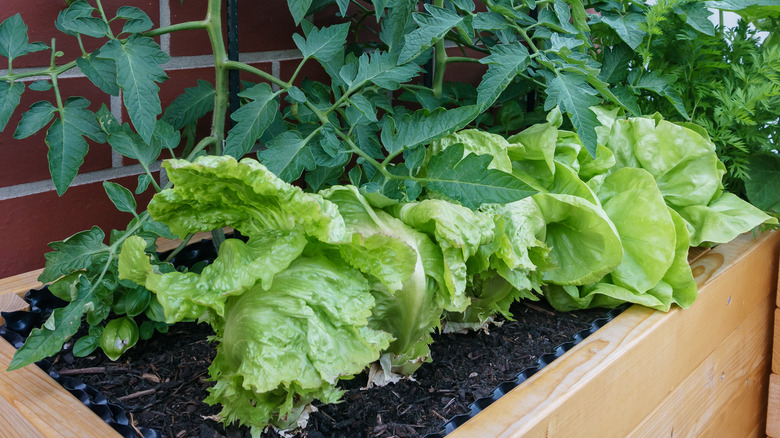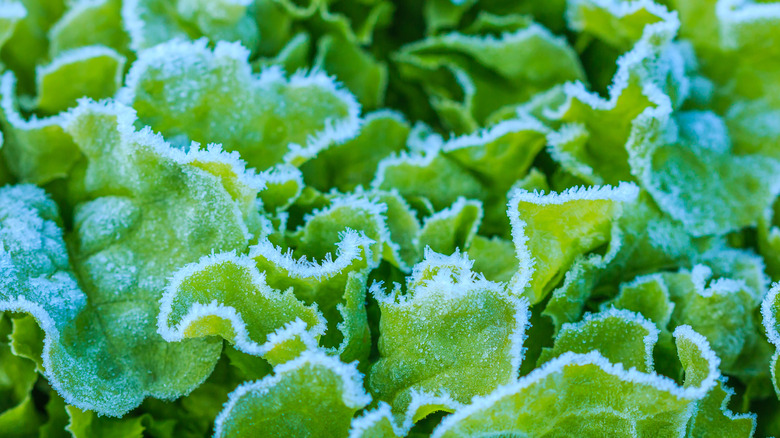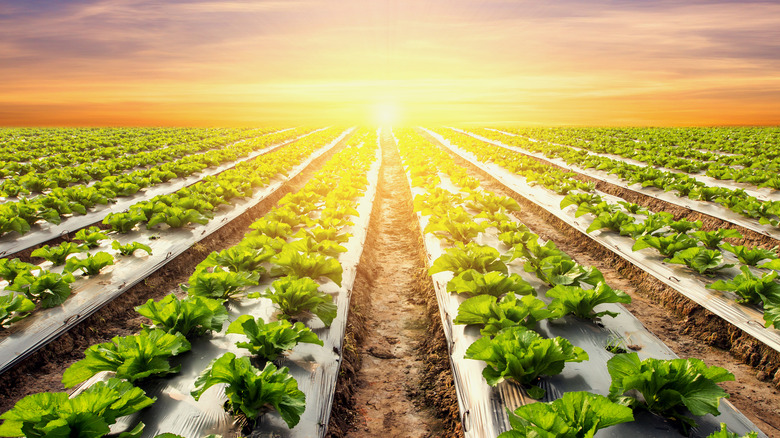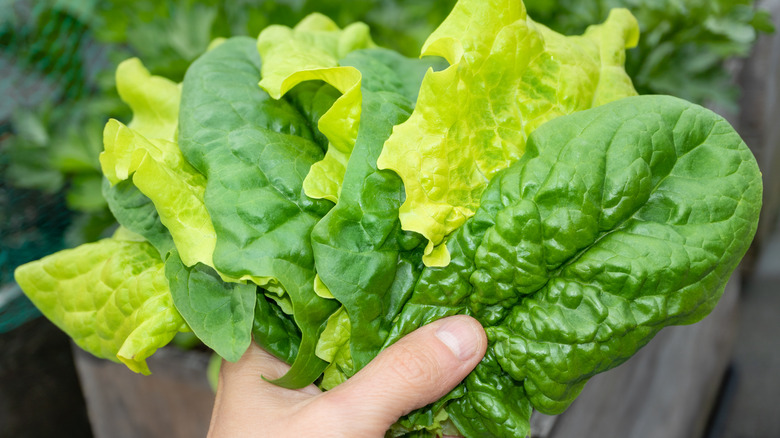Everything You Need To Know About Growing Your Own Lettuce
With the coronavirus pandemic leaving people housebound for a majority of the last year, many turned to gardening as a means of getting some time outside while still staying safe and socially distanced. According to an Axiom survey, there was a 42% increase in participation in the activity in 2020. Over 80% of survey respondents felt that their gardening last year was successful — so much so that 86% planned to continue with the hobby in 2021.
If you're inspired by these numbers and ready to head to the store to pick up a few seed packets, you may find yourself a bit overwhelmed with all of the options available. Even narrowing it down to a specific category, like vegetables, leaves a wide range of choices. Fortunately, Food Network has taken some of the work out of your decision and compiled a large list of veggies that are simple to grow yourself, even in the smallest of outdoor environments.
Out of the site's suggestions, one of the easiest to start with is lettuce. There isn't too much that goes into setting up a space to grow this leafy green, not to mention that it has a quick production rate, meaning you'll be enjoying fresh lettuce wraps or salads in a matter of weeks (via Gilmour). But before getting started, there are a few key pieces of information you should be aware of to ensure that your lettuce will thrive. Here's what you need to know.
Don't start growing your lettuce too early or too late
Often referred to as a "hardy" vegetable (via Gardener's Path), lettuce has a relatively long window of time that it can be planted and grown. Food Network says it is best to plant in the spring and fall, while Gilmour offers more specific parameters, noting that seeds can germinate in temperatures of anywhere between 40 and 85 degrees. This veggie is not a fan of hot weather, as it "panics" and starts to over-produce seeds — a process known as bolting that will give it a bitter taste (via Gilmour). Ultimately, lettuce does best when the temperatures hit between 60 and 70 degrees.
Meticulously checking the 10-day forecast will help determine the best time to get your lettuce garden started, but Food Network advises that there's something even more important to figure out: your area's first and last frost dates. As Garden Safe explains, the last frost is the "average final spring frost of your growing location," while the first frost is the typical date it first occurs in autumn (via Natria), and both can cause your lettuce seeds not to germinate. You can research the specific dates for your area online, but keep in mind that nature is unpredictable. Garden Safe notes that there is still a 10% chance that a frost can occur before or after the date listed.
Grow lettuce in a spot that gets plenty of sunlight
Though lettuce doesn't thrive in hot climates, it does love the sun. Make sure to pick a grow spot that gets plenty of sunlight — ideally six to eight hours a day (via Savvy Gardening) — as well as good drainage. The Spruce also suggests adding organic, nitrogen-rich amendments to the soil, like compost, before planting.
Once you've determined where to plant your future salad greens, it's time to get the seeds in the ground. They don't need to go too far into the soil, a half an inch at most, but it is important to know what type of lettuce you are growing to determine how much space you need in between each plant. According to Gilmour, the four main types are loose-leaf, romaine, butterhead, and head, the first of which only requires about four inches in between each seedling. Romaine and butterhead need six to eight inches, while head lettuce requires a little more.
When it comes to watering, the seedlings need to be doused in water every day, but only enough to ensure that the soil is consistently moist. As The Spruce puts it, "frequent watering is more important than deep watering."
Lettuce is ready to harvest in a matter of weeks
One of the best things about growing your own lettuce is that you won't be waiting too long to reap the benefits of your work. Certain varieties of this veggie, like loose-leaf lettuce, can be ready to harvest in as little as 30 days, according to Gilmour, while other types will be mature only a few weeks after that. Loose-leaf is also the gift that keeps on giving, meaning that you can trim a few leaves off at a time while leaving the bud of the plant intact to come back for more whenever you've got a hankering for a fresh salad (via Bonnie Plants). For head lettuce, however, you may want to wait for the entire plant to mature and then cut it close to the base.
No matter which type of lettuce you want to grow, it is widely suggested to harvest it during the morning hours. According to Burpee, this is when the leaves are "crisp, sweet, and full of moisture." Make sure to wash it before eating, and use it up sooner rather than later to avoid any wilting that may occur. However, if your homegrown lettuce does get droopy and unappetizing, you can try this genius trick to revive it.



